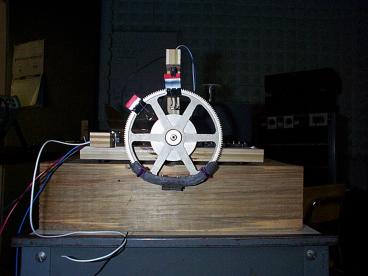Motor Control of an Oscillating Pendulum - PowerPoint PPT Presentation
1 / 23
Title:
Motor Control of an Oscillating Pendulum
Description:
System Block Diagrams. Original Schedule of Tasks to be completed. Work ... Compile H-bridge code with all other project codes. Goals Accomplished to Date ... – PowerPoint PPT presentation
Number of Views:61
Avg rating:3.0/5.0
Title: Motor Control of an Oscillating Pendulum
1
(No Transcript)
2
Motor Control of an Oscillating Pendulum
- Nick Myers and Chirag Patel
- March 9, 2004
- Advised by Dr. James Irwin and Mr. Jose Sanchez
- Bradley University Department of Electrical
Engineering and Technology
3
Presentation Overview
- Project Objectives
- System Block Diagrams
- Original Schedule of Tasks to be completed
- Work Completed (Nick)
- Work to be Completed (Nick)
- Work Completed (Chirag)
- Work to be Completed (Chirag)
- Revised Schedule of Tasks to be completed
- Summary of Progress
- Questions
4
Objectives
- To initialize the oscillation of a weighted
pendulum using microprocessor controlled motor
bursts. - To oscillate the pendulum to a predefined angle
and, using optical sensor outputs, maintain the
angle of oscillation.
5
System Level Block Diagram
6
Subsystem Level Block Diagram
7
Schedule of Tasks
8
Goals Accomplished to Date
- Motor control switch to allow user to switch
motor on/off - H-bridge hardware to allow motor to turn in both
directions - H-bridge microprocessor code to switch H-bridge
automatically based on pendulum location and
direction - Construction of our pendulum unit
9
H-bridge Hardware
10
H-bridge Hardware
- The H-bridge uses (4) N-Channel Power Transistors
- The H-bridge operates on a supply voltage of 15V
DC - The H-bridge ideally accepts input voltages of 0V
or 15V DC - Finding the appropriate transistors to power our
motor was difficult
11
H-bridge Microprocessor Code
- The H-bridge will switch motor burst direction
every time the pendulum passes equilibrium. - Once the direction is switched, a burst will
immediately be sent. - The H-bridge code will be called by the sensor
input interrupt.
12
H-bridge Microprocessor Code
13
Constructed Pendulum
14
Goals to be Accomplished
- Complete hardware interface for EMAC to H-bridge
- Calculate timing for motor burst lengths to be
called by H-bridge code - Create timing code that will burst the motor with
increasing lengths as pendulum period increases - Compile H-bridge code with all other project codes
15
Goals Accomplished to Date
- Optical Sensor with desired switching times and
code to read the sensors through EMAC. - PWM Signal Code to initiate oscillation.
- Pulse Width Measurement Code to control speed of
oscillation - Design of Pendulum Structure
16
Optical Sensor
- Two sensors to be used
- One at equilibrium
- Another at desired swing of oscillation
- RF 200 to limit current to 20 mA
- Enough current to transmit infrared signal
- Not enough current to damage Optical Sensor
- R1 4700 to account for desired on/off switching
times - ON Switching Time
- 8us 1.7 14.4 us
- OFF Switching Time
- 50us 1.6 80us
17
PWM Signal
- Current PWM signal 1khz _at_ 33 Duty cycle.
- Actual frequency will be much smaller.
- PWM signal will be used to initiate the
oscillation of the pendulum. - Once pendulum is beyond the equilibrium sensor,
timed pulse signals will be used to oscillate the
pendulum.
18
Pulse Width Measurement
- Pulse Width Measurement code used to measure
length of time sensor is obstructed by pendulum. - This time will be used to control the length of
the pulse sent to motor to control oscillation of
pendulum. - Faster oscillation Smaller pulses
- Slower oscillation Larger pulses
19
Goals to be Accomplished
- Construct code for the timed pulses of constant
length in order to sustain oscillation beyond the
equilibrium sensor. - Construct code to adjust the length of the timed
pulses which will be dependent upon the pulse
width measurement. - Construct code to maintain oscillation once the
predefined height sensor is reached.
20
Software Flowchart
21
Revised Schedule of Tasks
22
Progress to Date
- Completed motor on/off switch
- Completed H-bridge hardware
- Completed H-bridge software
- Partially completed EMAC to H-bridge interfacing
- Completed Optical sensor timing values and code
- Completed PWM signal code
- Completed pulse width measurement code
- Completed pendulum construction
23
Questions?































